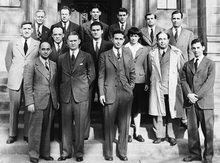Chicago Pile
Chicago Pile designates a series of experimental reactors . The first three of these reactors were part of the Manhattan Project , which aimed to build atomic bombs .
Chicago Pile 1
When the Chicago Pile 1 ( English pile , stack '), short CP-1 , the criticality reached, he was the first functional built by man nuclear reactor . The experimental facility was built by the Metallurgical Laboratory at the private University of Chicago . It should confirm the theoretical expectation that a self-sustaining fission chain reaction actually occurs. The metallurgical laboratory was built in 1942 by Arthur Holly Compton , a 1927 Nobel Prize in Physics. The reactor development had the goal of breeding weapons- grade plutonium from uranium- 238 for the Manhattan project .
CP-1 was built under the direction of the Italian physicist and Nobel Prize winner from 1938, Enrico Fermi , under a disused sports stand of the football stadium "Stagg Field" on the campus of the University of Chicago. Rackets (a forerunner of squash ) had previously been played in the room under the stands . Work on the originally planned facility in the small town of Palos Park could not be started due to a strike. The reactor core consisted of a 7.6 meter high, roughly spherical stack of blocks of 5.4 tons of uranium metal, 45 tons of uranium oxide and 360 tons of graphite . The graphite served as a moderator to slow down the neutrons so far that they trigger another fission. The uranium had the natural composition of isotopes . Cadmium sheets, which could be lowered into slots in the reactor core, were used to control the reaction . The intensity of the reaction could be observed by measuring the neutron flux .
The system contained rudimentary devices for an emergency shutdown . In an emergency, a helper assigned for this purpose would have cut the fastening rope of a control element hanging above the pile with an ax, which would then have fallen into the reactor and made it subcritical . In addition, for redundancy, a three-person team was available above the pile to flood it with a cadmium salt solution. Since then, the rapid shutdown of a reactor has been referred to as “scram” (from English to scram , “flee”, “run away”); The backronym Safety Cut Rope Ax Man is passed down from Fermi himself - obviously joking .
The first demonstration to invited guests took place on December 2, 1942, without any protection from radiation. Physicist George Weil partially pulled the control rods out of the reactor core while Fermi monitored the neutron flux. The nuclear reaction started at 3:22 p.m. and ended in 28 minutes.
Chicago Pile 2
Chicago Pile 1 was dismantled as early as February 1943 and, supplemented with lead plates for radiation shielding, rebuilt as Chicago Pile 2 in the originally planned site A in Palos Park .
Chicago Pile 3
On May 15, 1944, Chicago Pile 3 (CP-3) at the Argonne National Laboratory near Palos Hills , Illinois, USA, became critical, making it the world's first functioning heavy water reactor . After the suspicion of damage to the reactor's aluminum shell as a result of corrosion was raised in January 1950 , it had to be rebuilt and was then operated as CP-3 ′ from May 1950 to 1954. Both versions of the reactor were used for various research purposes.
Beginning of the war only the Norwegian Hydroelectric Company (produced Norsk Hydro ) in a fertilizer -Werk heavy water as a byproduct .
The radioactive waste from the dismantling of Pile 1 to 3 was buried in Site A / Plot M Disposal Site (Red Gate Woods).
Chicago Pile 5
Chicago Pile 5 operated from 1954 to 1979 . The heavy water reactor mainly produced neutrons for research with (in K-25 ) enriched uranium . The reactor was dismantled from 1991 to 2000. The building was still standing in 2009.
Others
The site of the former CP-1 reactor has had the status of a National Historic Landmark since February 18, 1965 and is also a Chicago landmark. The Regenstein Library, which opened in 1970, is located there today . A 4.3 m high sculpture Nuclear Energy by Henry Moore has been a reminder of the test facility since 1967. Graphite blocks of the CP-1 are (mitmach) Museum of Natural Science and Industry and the Bradbury Science Museum in Los Alamos ( New Mexico issued).
The world's first nuclear power plant in Obninsk in the USSR delivered a net output of 5 MW in 1954.
Web links
- atomicarchive.com: The First Pile
- deutschlandfunk.de , calendar page , December 2, 2017, Frank Grotelüschen: The ringing in of the atomic age
- Argonne National Laboratory , ne.anl.gov: Chicago Pile 1 (CP-1) 70th Anniversary
Footnotes
- ↑ Overall you can see: Back row from left: Norman Hilberry, Samuel Allison, Thomas Brill, Robert Nobles, Warren Nyer, Marvin Wilkening. Middle row from left: Harold Agnew , William Sturm, Harold Lichtenberger , Leona Woods , Leó Szilárd in a light coat. Front row from left: Enrico Fermi, Walter Zinn , Albert Wattenberg , Herbert L. Anderson . The recording was made on December 2, 1946 in Chicago, on the 4th anniversary of its success. However, a number of other scientists were also involved, such as Eugene Wigner , Robert F. Christy , Arthur Compton , Samuel K. Allison , Louis Slotin in a bright coat, Argonne National Laboratory, The Chicago Pile 1 Pioneers
- ↑ Edwin Blackburn: "Scram!" Reactor veteran recalls account of the birth of a key word in the nuclear vernacular. Oak_Ridge_National_Laboratory , September 2000, accessed June 21, 2016 . Etymology of SCRAM
- ↑ Wiese, EC: Large scale demonstration project at Argonne National Laboratory's CP-5 reactor (English) .
- ↑ Listing of National Historic Landmarks by State: Illinois. National Park Service , accessed July 22, 2019.







